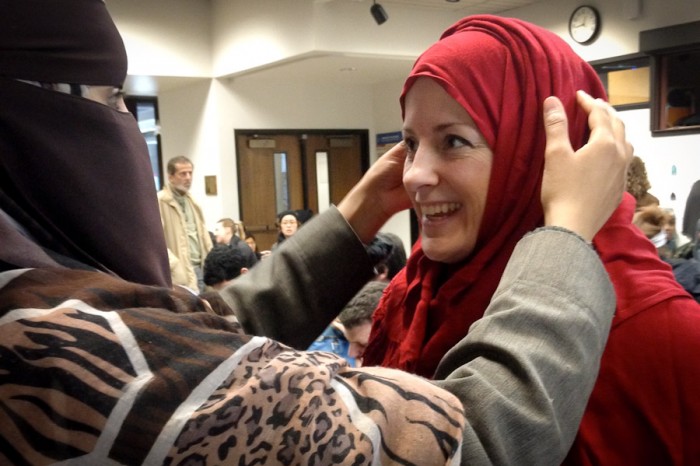Katya Yefimova’s short film “Hijabi” explores one woman’s experience growing up in Seattle wearing a headscarf.
Take a walk through North Seattle Community College’s chilly outdoor corridors on any week day, and you’ll find plenty of evidence of the school’s growing Muslim enrollment. You might see a person rolling out a prayer mat next to a vending machine, or a group of girls in various styles and colors of hijab chatting on their way to class.
In response to this strong Muslim presence on campus, the Diversity Advisory Committee at North Seattle Community College hosted Washington state’s only World Hijab Day event on Monday. The event included a talk by local slam poet Hamda Yusuf, the screening of a short documentary film, Under One Sky, and a demonstration of how hijabs are worn.
Wadiya Nelson, a campus librarian, was one of the main organizers for the event.
“I wanted to support the effort in creating safe spaces and places for students who choose to wear their hijabs on campus,” she said. “I wanted our campus community to know about the diversity of women who choose to wear the hijab.”
When Hamda Yusuf began her performance of the poem, “Just Another Towelhead,” the informal event space was less than half full. Students walked past the open doors on their way to and from the cafeteria. But Yusuf held the audience with confidence and poise. By the time she finished, the room was packed.
“I loved the slam poet,” said student Annika Fleming. “When she said ‘and no, it’s not a towel,’ I immediately got goosebumps and teared up. The hijab has so much history, power, and choice behind it, it is sad to think anyone would compare it with something that you clean up spilt soup with.”
Yusuf told the audience that spoken word had helped her connect with her sense of agency, as well as her capacity for anger.
“I am loud, and I am Muslim, and I am a girl and those things are not separate,” she told the audience.
Following a brief Q & A with Yusuf, the organizers provided a break where non-Muslims could try on the hijab. This was in conjunction with the invitation issued by the larger World Hijab Day movement, which marked its celebration on Saturday.

International students, in hijabs as well as mouth-covering niqabs, instructed non-Muslims on the proper wrapping technique to keep the fabric in place. The event organizers also invited men to try the hijab, although none present took advantage of the offer.
Sara Linde, a full-time student who accepted the invitation to try hijab for a day, felt inconspicuous on campus. But later on the bus, “there were some looks. One teen outright stared at me. Not maliciously, but definitely staring.”
Following the demonstration, there were many more hijab-covered heads, as people sat back down to watch the short film, Under One Sky. The film helped connect the World Hijab Day event to the college’s academic identity, as it highlighted the symbolism of the veil, and the ways hijab has been used historically to justify forms of global imperialism.
UW student Nura Marouf explains how to put on a hijab. (Video by Katya Yefimova)
Considering the number of women who wear the hijab on campus, it’s important for the college community to understand the meaning of the veil, said Karen Stuhldreher, an instructor who tied the event to the curriculum of her integrated studies course, Bodies Revealed: Representations of Gender, Race, and Sexuality in the Media.
“I personally would like to see that there is more understanding of the multiplicity of reasons and motivations for veiling and also more awareness of the diversity of women who do veil,” Stuhldreher, who was also an organizer for the event, said via email. “They are often perceived to be ‘oppressed’ or ‘repressed’ or subjugated, and even uneducated.”
Following the conclusion of the Hijab Day event at 2pm, participants went back to their lives as students and teachers and staff members. But their hijabs remained in place.

